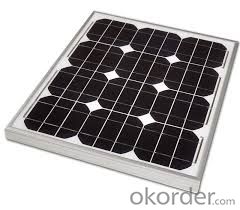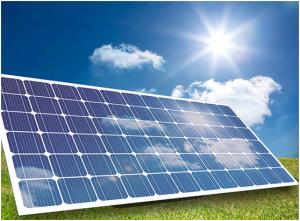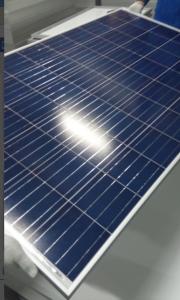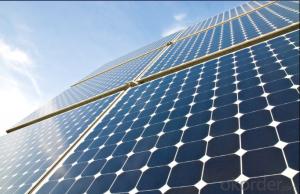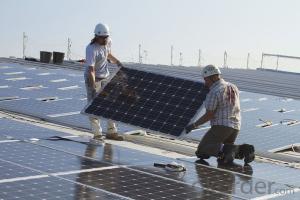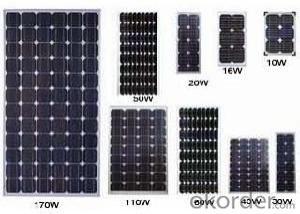Solar Panels Omaha Hot Sale Mini Monocrystalline Solar Panel CNBM
- Loading Port:
- Qingdao
- Payment Terms:
- TT OR LC
- Min Order Qty:
- 10 set
- Supply Capability:
- 300000 set/month
OKorder Service Pledge
OKorder Financial Service
You Might Also Like
Monocrystalline Solar Panel with 160W
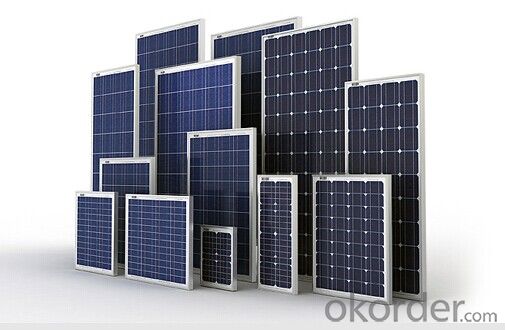

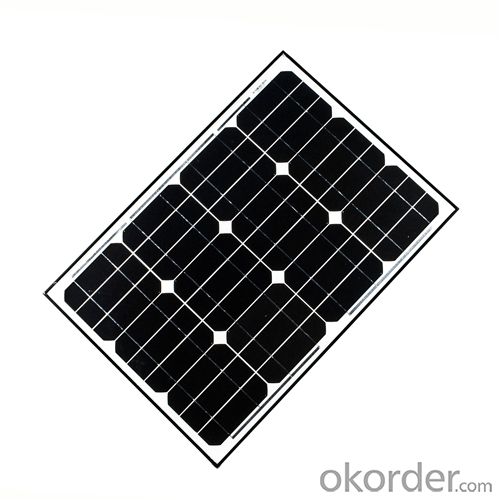
Monocrystalline Solar Modules
We offers a range of small, medium and large monocrystalline solar modules, designed for a range of requirements.
Specifications:
Tolerance | +/- 3% |
Cell | Monocrystalline silicon solar cells |
N0. of Cells | 72 (12 x 6) |
Dimension of Modules (mm) | 1581 x 809 x 40 |
Weight (kg) | 15.5 |
Limits:
Operating Temperature | -40~+85? |
Storage Temperature | -40~+85? |
Maximum System Voltage | 1000 VDC max. |
Hail Impact | Diameter of 28mm with impact speed of 86km/h |
Temperature and Coefficients:
NOCT | 48C+/-2? |
Voltage temperature coefficient (%/K) | -0.34 |
Current temperature coefficient (%/K) | 0.09 |
Power temperature coefficient (%/K) | -0.37 |
Characteristics:
Model: | SGM-160D | SGM-165D | SGM-170D |
Max-power voltage Vmp (V) | 34.5 | 35.4 | 35.8 |
Max-power current Imp (A) | 4.64 | 4.66 | 4.75 |
Open-circuit voltage Voc (V) | 41.75 | 43.6 | 43.32 |
Short-Circuit Current Isc (A) | 5.32 | 5.08 | 5.38 |
Max-power Pm(W) | 160 | 165 | 170 |
Model: | SGM-175D | SGM-180D | SGM-185D |
Max-power voltage Vmp (V) | 36.1 | 36.2 | 36.2 |
Max-power current Imp (A) | 4.85 | 4.97 | 5.11 |
Open-circuit voltage Voc (V) | 43.68 | 43.8 | 44.8 |
Short-Circuit Current Isc (A) | 5.49 | 5.48 | 5.51 |
Max-power Pm(W) | 175 | 180 | 185 |
STC: Irradiance 1000W/m2, Module temperature 25?, AM=1.5
Monocrystalline Solar Panels Specifications Range
Maximum Power (Pm) | Dimension | Weight | Operating Voltage (Vmp) | Operating Current (Imp) | Open Circuit Voltage (Voc) | Short Circuit Current (Isc) |
3W | 158x241x25mm | 0.5kg | 8.5V | 0.36A | 10.5V | 0.4A |
4W | 308x166x25mm | 0.77kg | 8.5V | 0.47A | 10.5V | 0.54A |
4W | 308.x166x25mm | 0.77kg | 16.8V | 0.24A | 21V | 0.27A |
5W | 296x215x25mm | 0.3kg | 16.8V | 0.48a | 21V | 0.54A |
10W | 286x406x25mm | 1.5kg | 16.8V | 0.59A | 21V | 0.66A |
12W | 286x406x25mm | 1.5kg | 16.8V | 0.71A | 21V | 0.8A |
14W | 286x541x25mm | 2kg | 16.8V | 0.83A | 21V | 0.96A |
16W | 286x541x25mm | 2kg | 17.2V | 0.93A | 21.5V | 0.99A |
18W | 296x541x25mm | 2.4kg | 18.8V | 1.07A | 21V | 1.2A |
20W | 296x641x25mm | 2.4kg | 17.2V | 1.15A | 21.5V | 1.24A |
24W | 541x451x25mm | 3.15kg | 16.8V | 1.14A | 21V | 1.56A |
26W | 541x451x25mm | 3.15kg | 17.2V | 1.51A | 21.5V | 1.63A |
30W | 296x966x25mm | 3.85kg | 16.8V | 1.78A | 21V | 2.03A |
36W | 541x641x35mm | 4.7kg | 16.8V | 2.14a | 21V | 2.4A |
40W | 541x641x35mm | 4.7kg | 17.2V | 2.33A | 21.5V | 2.5A |
55W | 1057x457x35mm | 6.6kg | 17.6V | 3.12A | 21.6V | 3.3A |
70W | 546x1196x35mm | 8.5kg | 16.8V | 4.15A | 21V | 4.7A |
75W | 546x1196x35mm | 8.5kg | 17.2V | 4.36A | 21.5V | 4.8A |
80W | 546x1196x35mm | 8.5kg | 17.6V | 4.55A | 21.6V | 4.9A |
110W | 1066x811x40mm | 11.8kg | 17.6V | 6.25A | 21.6V | 6.6A |
150W | 1066x811x40mm | 14kg | 34.4V | 4.36A | 43.2V | 4.7A |
- Q: Can solar panels be used for powering construction sites?
- Yes, solar panels can be used to power construction sites. They can provide a sustainable and renewable source of energy, reducing reliance on traditional power sources and minimizing environmental impact. Solar panels can be installed on rooftops, scaffolding, or ground-mounted systems to generate electricity for various construction activities, including powering tools, lighting, and other equipment required on-site.
- Q: Hi. I have been looking into getting solar panals but I only want them for one room. See, we're expanding the house by adding a basement, the basement isn't going to be that big but we wanted to have solar energy for the basement only. Could anyone give me a rough estimate on the cost of solar panals for my basement?
- Only after you give an estimate of the power consumption you will have in the basement. Obviously you do not have a clue about solar panels or their usage. Suggest you find a book and start reading.
- Q: How much space is required for solar panel installation?
- The amount of space required for solar panel installation can vary depending on factors such as the size and type of panels, the energy needs of the property, and the available sunlight. On average, a typical residential solar system may require anywhere from 100 to 600 square feet of roof space, but ground-mounted systems can also be an option for properties with ample land. It is best to consult with a solar installation professional to determine the specific space requirements for your particular situation.
- Q: I am working on a project and I have to build a house with solar panels. My teacher asked me how would I get solar energy if it is rainy or cloudy? I looked it up but didn't understand. Please help me!!
- Solar panels convert light energy into electrical energy with the photovoltaic process. They work best when perpendicular to the incoming sunlight and with no clouds in bright sunlight. They will work at reduced efficiency if there are clouds or rain, but as long as its not dark, they will still produce some electricity. That is one of the real problems with solar energy, as we expect to have electricity available on demand, regardless of day/night cycles and atmospheric conditions. Storing electricity is very inefficient, so we need hydro, nuclear,or fossil fuel energy to provide firm on demand energy as a base load.
- Q: i know that a solar panel of square meter generate 000 watts on a clear and sunny day, but i need to know the time rate. is it 000 watts per day or per hour? Thanks.
- 000W/square meter is the standard input rate that solar panels are rated by. Watts are a rate, like miles per hour. Depending on the technology, you might get as much as 20% of that as an output of the panel. To determine the amount of power generated, you need to multiply the rate by time. Just like in a car, going 50mph for 5 hours sends you 250 miles. You look at the rating of the panel, if it is a 50 watt panel, in 5 hours AT THAT RATED INPUT, you would generate 250 watt hours (wh). You can find charts that tell you how many sun hours are available a day. As the sun is generally strongest at solar noon, it is weaker in the morning and afternoon. They have averaged the power of the sun throughout the day, and said for each location, how many hours equal to 000W/Msq are in a day. Five is a nice average number. So, if you figure 000W input in a square meter, 20% output, or 200W (the rate) times 5 sun hours (time) = 000Watt hours, or kilowatt hour ( kwh) (quantity) can be generated from a square meter of panels in a day.
- Q: Can solar panels be installed on a factory or industrial facility?
- Yes, solar panels can be installed on a factory or industrial facility. In fact, many factories and industrial facilities have started adopting solar energy as a renewable and sustainable source of power. Installing solar panels on such facilities can help reduce their carbon footprint, lower electricity costs, and provide a reliable source of clean energy.
- Q: how much energy does a kilowatt solar panel produce in a year? (average)
- You would be amazed how often I have answered this question. The answer is that it depends on your latitude and local weather . Let's see if I can give you enough information so that you can determine the answer for yourself. A kW solar panel is rated at kW when it is exposed to a solar flux of kW/m^2 (called a peak sun hour). There are readily available tables of effective peak sun hours per day by city (see Reference ). Let's use Fairbanks, AK as an example (it is the first line of the table). Fairbanks get an average of 3.99 of peak sun hours per day on average. So your panel would produce 3.99 kW*hr per day on average.
- Q: Here's a little idea I though might help everyone out in Iraq a little: How about if the US mass produces solar panels that are small enough to carry (maybe one foot by three feet) that have a regular power outlet on them to the Iraqis? We could send convoys to the people waiting in line to buy gas and give each person one free solar panel. Why?. A lot of people are buying gas to run generators for air conditioning, not to fuel vehicles. 2. It would help reduce the gas lines if people only needed gas for cars instead of their generators too.3. It would help reduce the fighting over the power grid if people didn't need the grid for their own electrical power.My theory is, once every family in Iraq has enough of these panels that they don't even care about the power grid (during the daytime anyway) it would be much easier to fix the power grid. Maybe these solar panels could even connect to and add to the power grid.
- I have a better idea . Why don't we pull our troops out of there and take the money that we spend to kill people and build a mass amount of solar cells and hand them out to our own people maybe give one of our hungry people a little food to go with it . You could even take a little of that money and put some kids through college . I can think of thousands of things to do with that cash . Why don't we ever take care of our own people first ?
- Q: Can solar panels be used in multi-story buildings?
- Yes, solar panels can be used in multi-story buildings. They can be installed on the rooftops or facades of these buildings to harness solar energy and generate electricity. Additionally, advancements in solar panel technology have made it possible to integrate them into building materials, such as windows or cladding, allowing for even more flexibility in their use in multi-story structures.
- Q: Does anyone know the earnings potential for the actual fitter of pv solar panels,and the electricians earnings.ty.
- it depends on your solar panel, but you can sure supply most if all of your electronics and electric stuff in your house on a sunny day. If you want to know exactly how much power it supplies and how much $$ you can save you simply have to calculate how much power your home consumes per day/month. I know of people totally reliable on solar power for their home and I too will put solar panels on my home one day.
Send your message to us
Solar Panels Omaha Hot Sale Mini Monocrystalline Solar Panel CNBM
- Loading Port:
- Qingdao
- Payment Terms:
- TT OR LC
- Min Order Qty:
- 10 set
- Supply Capability:
- 300000 set/month
OKorder Service Pledge
OKorder Financial Service
Similar products
Hot products
Hot Searches
Related keywords



